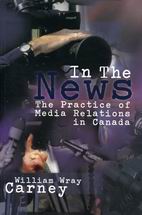|
Do you have a message to convey but panic at the thoughts of having
to talk to the media? Never fear. Former journalist William Carney
has written a much-needed guide that will help you overcome your
fear and master the art of media relations.
In the News, The Practice of Media Relations in Canada gives
everyone, from student to seasoned practitioner, a thorough understanding
of who the media are, how they work and how to approach them with
stories. If ever you needed a lesson or a reminder of how to be
media savvy - this is it.
The first step, if you haven't realized it already, is to acknowledge
media relations as "one of the mainstays of the communications
business." Carney's introduction emphasizes that "more
opportunities exist than ever before for being 'in the news' and
using news media as a means to communicate your issues to the public
at large or to very targeted groups."
Then he proceeds to give us an easy-to-read, comprehensive instruction
manual on how best to capitalize on these opportunities.
Carney's book, by his own definition, "is research-based and
provides both a practical and a philosophical guide to dealing with
media and reporters". It doesn't read like a text book. It
reads like a precise, how-to guide for people intent on adopting
a media-friendly communications style that is ethical, proactive
and gets results.
Carney acknowledges that sometimes media relations involve more
than providing factual information to a reporter. When a more "thoughtful,
strategic and planned approach" is required, Carney provides
the means by which to formulate and mobilize a communications business
plan, including the situation analysis, research, policies and procedures,
media training and evaluation.
Then Carney takes the "mystery" out of what drives the
news. He gives clear instruction on how to find and write a good
lead for a media release, how to make the best use of media conferences
and attention-grabbing media stunts, while shedding light on many
do-it-yourself techniques like letters to the editor, advertorials
and community cable programming.
He continues the lesson by revealing the attributes of a good interview,
how to conduct one and how to prepare for basic question and answer
sessions.
The book comes to a close with a chapter on "The Fine Art
of Complaining About the Media". After all, the media are people
too and prone to making mistakes. How to correct those mistakes
is Carney's final lesson.
I highly recommend this book for anyone involved in communications.
Mastering the art and science of media relations is a powerful tool
in your communications arsenal. The why and when of your talking
to the media may as yet be uncertain. At least Carney is here to
tell you how.
See also:
Nurturing
your relationships with reporters
Effective
Media Relations
HotLink
Resource Shelf - #30 _Review of Media Relations by Allan Bonner
Lynn Fenske
“putting your ideas in writing”
E-mail: writer@lynnfenske.com
www.lynnfenske.com
| 

